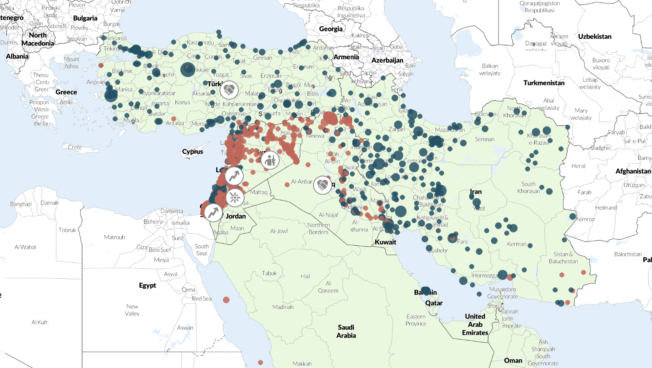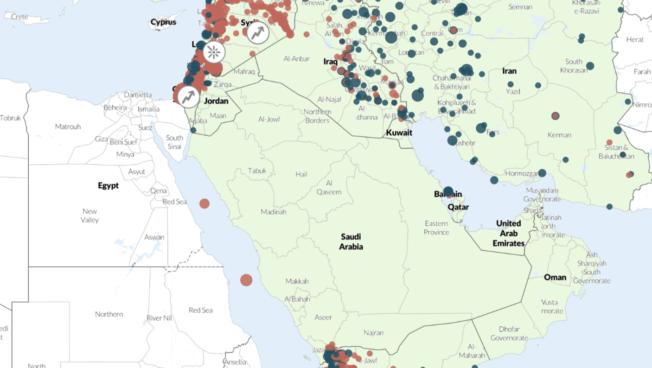Regional Overview
Middle East
August 2024
Posted: 6 September 2024
In this Regional Overview
- Lebanon: Hezbollah responds to top commander’s killing, averting full-scale war for now
- Palestine: The IDF intensifies operations in the West Bank and fighting continues in the absence of a deal in Gaza
- Red Sea: Houthis attacks against ships grow in complexity and ferocity
- Syria: The reopening of the Abu Zandin crossing leads to further unrest in Aleppo province
Lebanon: Hezbollah responds to top commander’s killing, averting full-scale war for now
Following the assassination of Ismail Haniyeh in Tehran and Hezbollah senior commander Fuad Shukr in Beirut at the end of July, concerns run high throughout August over a significant retaliation by Hezbollah and Iran that would push the region into a broader, full-blown war. Amid these concerns, the US bolstered its military presence across the region for the second time since the start of the war in Gaza.1Phil Stewart and Idris Ali, ‘U.S. to send more warships, fighter jets to Middle East to bolster defenses,’ Reuters, 3 August 2024 Israel also intensified its attacks on southern Lebanon throughout the month, with IDF attacks in Lebanon leading to over 40% more reported fatalities compared to July.
On 25 August, in the early hours of the morning, Hezbollah launched the anticipated retaliatory attack, firing hundreds of rockets and deploying drones against Israel, claiming to target 11 military bases in northern Israel, the Golan Heights, as well as an intelligence unit in central Israel. However, only a few hits were confirmed. The attack was less intense than expected, with no precision missiles used. Importantly, over 100 Israeli jets conducted preemptive airstrikes at dawn on approximately 40 locations across southern Lebanon, targeting what Israel claimed were hundreds of Hezbollah rocket launchers, likely preventing a larger-scale attack (for more, see this ACLED Insight). On 25 August, Hezbollah launched the largest number of projectiles2Jonan Jeremy Bob, ‘Hezbollah launches largest rocket attack on Israel’s North since last month,’ The Jerusalem Post, 4 September 2024 and the IDF carried out the largest number of airstrikes targeting Lebanon since the start of the current round of hostilities in October. Both sides have in the meantime pulled back from escalation, but tensions continue to remain high.
Palestine: The IDF intensifies operations in the West Bank and fighting continues in the absence of a deal in Gaza
Amid international pressure for a deal to halt the fighting in Gaza and release remaining hostages, Israeli forces continued their ground offensive in Gaza throughout August, with armed clash events remaining at similar levels as in the past two months. The Israel Defense Forces (IDF) concluded a three-week ground operation in Khan Yunis, while it continued its ground operations in the al-Zaytun and Nezarim areas of Gaza City, as well as east of Dayr al-Balah. The IDF also continued its airstrikes, which have been steadily intensifying since June, also hitting civilian targets, including at least 10 schools that host displaced Palestinians, killing hundreds, including women and children. The IDF claims that Hamas uses these sites as hideouts.3Emanuel Fabien, ‘IDF says it struck Hamas command rooms in UNRWA schools in Gaza City,’ Times of Israel, 4 July 2024
Various rounds of negotiations were held in both Egypt and Qatar throughout the month, with disagreements over Israel’s future military presence in Gaza, especially in the Netzarim Corridor, obstructing any deal. On 29 August, Israel’s military and Hamas agreed to three separate, zoned three-day pauses in fighting in Gaza to allow for the first round of vaccination of over 500,000 children against polio in Gaza following an outbreak.4Yolande Knell, ‘Gaza polio vaccine rollout starts well, UN says,’ BBC, 1 September 2024 Meanwhile, the body of an abducted Israeli soldier was recovered on 28 August, while six more bodies were discovered in a tunnel in Rafah on 31 August. Hamas is still holding 97 hostages, but at least 33 are believed to already be dead.5Shira Rubin, Niha Masih,Joanna Slater and Lior Soroka, ‘Protests escalate in Israel after 6 hostages’ bodies are recovered in Gaza,’ Washington Post, 1 September 2024
Meanwhile, tensions in the West Bank significantly escalated in August, with the IDF carrying out intensified operations targeting Palestinian militants, particularly in the northern areas of Tulkarm, Jenin, and Nablus. The IDF used heavy weaponry, including missiles, and conducted nearly a dozen drone strikes throughout the month. Amid a failed suicide attack in Tel Aviv on 18 August — the first such attack in nearly eight years,6Matthew Mpoke Bigg and Gabby Sobelman, ‘Hamas and Islamic Jihad Claim Responsibility for Tel Aviv Bombing,’ New York Times, 19 August 2024 for which Hamas and PIJ claimed responsibility — and calls by top Hamas official Khaled Mashal for the resumption of suicide bombings in the West Bank,7‘Top Hamas official Mashaal urges resumption of suicide bombings against Israel,’ Times of Israel, 29 August 2024 on 27 August the IDF launched the largest operation in the West Bank since 2002.8Naomi Neumann, ‘Prioritizing the West Bank Amid Escalation and Deterioration,’ The Washington Institute, 30 August 2024 The operation involved hundreds of Israeli troops backed by helicopters, drones, and armored personnel carriers, and continued into September. During the operation, at least two civilians and 24 Palestinian militants were killed. Notably, Israeli forces killed the leader of Katibat Tulkarm on 27 August and the local head of Hamas in Jenin on 30 August.
Correction: An earlier version of this section incorrectly said that the bodies of an abducted Bedouin and Israeli soldier were recovered from a tunnel in Rafah. In fact, the abducted Bedouin was rescued alive.
Red Sea: Houthis attacks against ships grow in complexity and ferocity
Houthi forces continued to threaten maritime routes in the Red Sea and the Gulf of Aden throughout August. On 21 August, Houthi forces attacked the Sounion — a Greek-owned and flagged crude oil tanker — in the Red Sea, severely damaging it and forcing its crew to abandon the ship. The attack featured a complex modus operandi, already applied in the case of the attack on the Tutor bulk carrier in June: Militants first fired at the ship from skiffs before targeting it with missiles, drones, and a drone boat. Two days later, Houthi forces boarded the abandoned ship, rigged it with explosives, and detonated it, causing multiple fires. Simultaneously on 21 August — and into the next day — Houthi forces targeted the Panama-flagged container ship SW North Wind I on at least five distinct occasions, causing minor damage, as it transited through the Gulf of Aden and the Red Sea. This is the highest number of individual targeting attempts on the same ship that ACLED records since the Red Sea crisis began last year. As with the attack on the Sounion, the Houthis used missiles, drones, and drone boats.
The Houthis also used sea mines in the Red Sea for the first time since the Red Sea crisis began, targeting the Liberia-flagged Delta Atlantica on 13 August. The complexity and persistence of these attacks reflect the Houthis’ increasingly sophisticated warfare methods in the Red Sea (for more see this ACLED report). The Houthis began attacking ships in November 2023 in response to Israeli military operations in the Gaza Strip and in purported solidarity with Palestinians.
For more, see the Red Sea attacks interactive map created as part of the Yemen Conflict Observatory.
Syria: The reopening of the Abu Zandin crossing leads to further unrest in Aleppo province
The Syria-Turkey rapprochement has been a focal point of daily protests in Idleb and Aleppo provinces in recent months. ACLED records nearly 40 demonstrations against the rapprochement across the two provinces in August, which marks a decrease in the number of demonstrations compared to the preceding month. Yet, attempts to reopen the Abu Zandin crossing, which serves as an unofficial trade route between rebel- and government-held areas, provoked further tensions in Aleppo province in August. The crossing, operational since December 2017, was closed in March 2020 due to the COVID-19 pandemic. An attempt to reopen it in June failed after local residents and opposition rebels burned crossing infrastructure.9Diaa Audi, ‘Abu Zandin in Northern Syria..The Context and Implications of a “Test Balloon,”‘ Al-Hurra, 30 August 2024 A second attempt to reopen the crossing in August sparked new demonstrations by locals and opposition armed groups who brand the reopening as part of a broader normalization of relations between Turkey and Syria. Hours after its official reopening, the crossing was shelled twice by an unknown armed group, injuring members of the National Police Forces. Meanwhile, locals and opposition rebels blocked goods trucks and staged a sit-in. At the same time, some residents of al-Bab city protested in support of the reopening and called for the closure of all smuggling routes.
See More
See the Codebook and the User Guide for an overview of ACLED’s core methodology. For additional documentation, check the Knowledge Base. Region-specific methodology briefs can be accessed below.
Links:
For additional resources and in-depth updates on the conflict in Yemen, check our dedicated Yemen Conflict Observatory.







